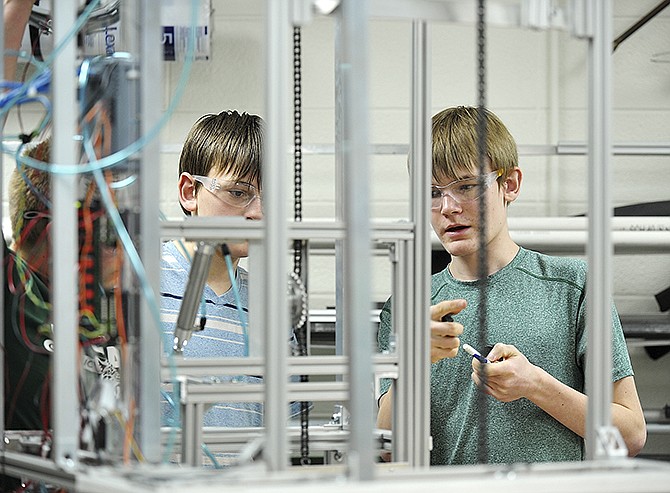Working with computer programming, electronic circuits, Plexiglass and a kit of interchangeable frame parts, students at Jefferson City's Simonsen 9th Grade Center built their first robot, which they dubbed "Baxter," moments before their competition this winter.
The FIRST Robotics program, founded by inventor Dean Kamen, has been around for more than 20 years with more than 300,000 participants ages 6-18 from more than 70 countries.
Although this is Simonsen's first year with a team, many Mid-Missouri schools and 4-H clubs have been hosting teams for years. Camdenton, in particular, has multiple teams at several age levels.
Lincoln University and ABB have sponsored a high school team for four years, and Lewis and Clark Middle School has had a Robotics Club for many years.
FIRST Robotics says "it's the hardest fun you'll ever have."
The project's goals are to raise awareness of robotics and to make technology "cool," said Lincoln team mentor Greg Pierson.
Simonsen competed in the varsity level, creating an 18-inch-square robot.
Preparing a robot at the highest level, the ABB Perpetual Recursion Robotics Team is working on a 28-by-42-by-78-inch robot weighing 120 pounds, Pierson said. Their deadline is Tuesday, then they will compete in March for a chance to advance to the world competition.
Most of Perpetual Recursion's members come from home-schooled families.
At Simonsen, students were invited from the Business Management and Technology Academy and the Industrial Engineering and Technology Academy.
Starting with a kit, the Simonsen team of about 15 began building a robot from scratch, said Parrish Morris. Then they bought another kit and, with a better understanding of where they were headed, divided into specialized groups.
The computer programmers and design engineers had to work back and forth to figure out the best composition for Baxter. Another group worked on marketing, creating team T-shirts, interacting with team sponsors and recording their progress.
The FIRST Robotics game this year was called "Cascade Effect." The objective was to build a robot that could scoop balls from the floor to fill tall, vertical containers. Not only must the design allow for those actions, but the robot must be programmed for both remote control and independent operation.
"We went through a lot of different strategies," said Matthew Hall. "We knew what our robot could do."
At the competition, they were timed and measured by the number of balls collected. But all of the robotics teams at the competition were eager to share ideas and tools, the students agreed.
"It was amazing once we put it on the ground and we moved it with the controller," Morris said.
Science teacher Mike Hall said he looks forward to what the team will be like next year, recruiting new freshmen and having this year's team return as sophomores.
"In a couple of years, maybe we'll even have two robots," Hall said.
But the program is not cheap. They benefited from start-up funds from the school board and a Rookie Team Grant through FIRST.
"Hopefully we can find more grants or local sponsors," he said.
Local businesses did provide some guidance for the team. Bartlett & West talked to the students about the process of engineering design. High Five Communications helped the students design the JayBots logo. And Brady's Glass donated the Plexiglass for the body.
"This was for sure a learning experience for students and teachers," Hall said. "We were just as new to it as the kids were. At first, we couldn't offer solutions, either."
Problem solving plays a large role in the Robotics Club. They also learn "gracious professionalism," cooperation and compromise.
"I feel like I learned a lot more doing this than sitting down in front of a screen," Matthew Hall said. "And we learned how to work with each other."
For students like Morris and Matthew Hall who want to pursue an aerospace career, their experience in the club has confirmed their interest.
"We don't give kids enough opportunities to experience STEM (science, technology, engineering and math) fields in school, but we're making efforts," said Mike Hall. "This is a perfect opportunity to get their hands dirty and try it."
Link:

